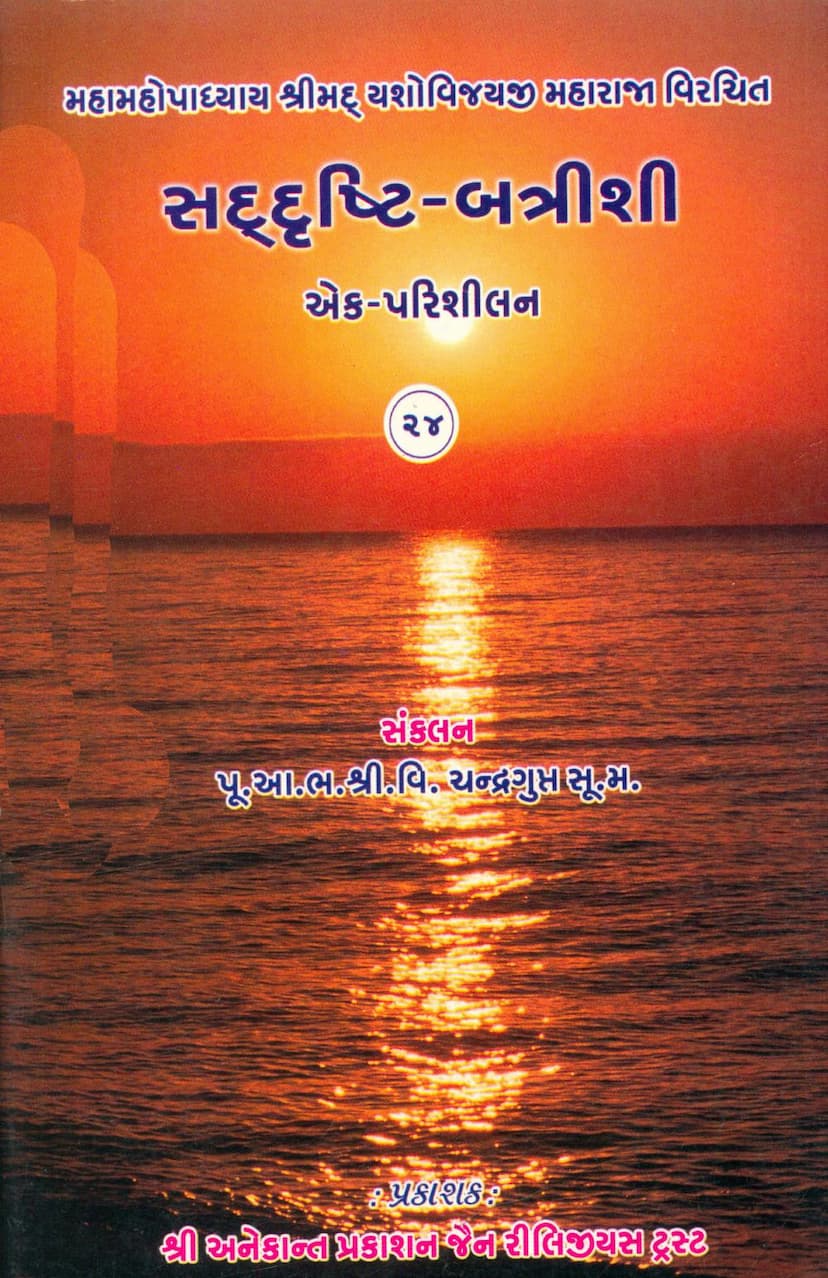Saddrashti Battrishi Ek Parishilan
Added to library: September 2, 2025

Summary
This document is a scholarly analysis (Parishilan) of the "Sadrashti Battreeshi" (Thirty-two Right Views/Perspectives) authored by Mahamahopadhyay Shrimad Yashovijayji Maharaj, compiled by Poojya A. Chadragupt Suriji. The text describes a progression of spiritual insight and practice within Jainism, leading towards liberation.
Here's a breakdown of the content based on the provided pages:
Overall Purpose:
The primary goal of this text is to provide a detailed explanation and commentary on each of the thirty-two "Sadrashti" (Right Views) presented in Yashovijayji's original work. The commentary aims to clarify the subtle meanings and practical implications of these insights for spiritual seekers.
Key Concepts and Structure:
The text explains that the "Sadrashti Battreeshi" follows a previous discussion on overcoming erroneous reasoning. The attainment of these thirty-two right views is presented as a result of withdrawing from sensory attachments. The text then systematically elaborates on each of these views, correlating them with various stages of yogic practice and spiritual development.
Progression of Views and Practices:
The commentary highlights a progression through different levels of spiritual attainment, often linked to the eight limbs of Yoga (Yama, Niyama, Asana, Pranayama, Pratyahara, Dharana, Dhyana, Samadhi). The following are some of the key views and their associated concepts discussed:
-
Sthira Drishti (Stable View):
- Characterized by Pratyahara (withdrawal of senses).
- Achieves a subtle understanding and freedom from illusions.
- Sensory pleasures are seen as ultimately meaningless and even harmful, like the smoke from sandalwood creating fire.
- The true self (Atman) is recognized as the ultimate reality, and all else is considered illusory.
- There's a realization that the fruits of good and bad karma are ultimately equal because they both bind one to the cycle of birth and death.
-
Kanta Drishti (Pleasant/Desirable View):
- Characterized by Dharana (concentration).
- The understanding is like the brilliance of stars, constant and clear.
- Anyamud (fixation on other things) is absent because the mind is focused on the true essence.
- Mimamsa (contemplation/analysis) arises, leading to a deeper understanding of the truth.
- The yogi remains unaffected by worldly pleasures, seeing them as illusory like a mirage.
- The yogi’s mind is firmly established in Dharma (righteousness).
- The practice of Dharana makes the yogi beloved to all beings and keeps their mind focused on Dharma.
- The pleasures of the world are not seen as a cause for further rebirth.
- The inherent strength of Dharma is not diminished by the practice of experiencing worldly pleasures.
-
Prabha Drishti (Luminous View):
- Characterized by Dhyana (meditation).
- This stage is described as the essence of meditation, leading to the realization of truth.
- It is free from defects and signifies righteous conduct (Satpravrutti).
- The focus is on Satpravrutti (righteous conduct) and Asanganushthan (non-attached practice).
- This practice is described by other philosophical schools with terms like "Prashantavahita" (serene flow), "Visabhaga Parikshaya" (destruction of disparate elements), "Shivavarma" (path to liberation), and "Dhruvadhva" (eternal path).
- The meditator achieves a state of Samadhi, which is the cessation of all mental modifications and the realization of the pure self.
- The happiness derived from meditation is Atmayatta (self-dependent) and not dependent on external factors.
-
Para Drishti (Supreme View):
- Characterized by Samadhi (absorption/union).
- This is the highest stage of yogic practice, free from attachments and the desire to act.
- The yogi is Nirachara (without the need for specific ritualistic actions) because the karmic impurities that necessitate such actions have been exhausted.
- The actions of the yogi are considered equivalent to one who has already eaten, as they are beyond the need for further sustenance or action.
- The distinction between the "study" of gems and the "handling" of gems is used to explain the difference in the nature of actions before and after attaining this stage. The former is for learning, the latter is for practice.
- The yogi, through Dharmasanyas Yoga (yoga of renunciation of Dharma-related activities), becomes Krutakrutya (accomplished/fulfilled).
- This leads to the attainment of Kevalashri (omniscient glory) and the fulfillment of all Laddhis (spiritual powers).
- Ultimately, the yogi attains Yoganta (the end of yoga) or Kaivalya (absolute liberation), reaching the abode of supreme bliss.
Commentary Style:
The commentary by Chandragupt Suriji is detailed, drawing upon classical Jain texts like the Yogadarshana Sutra and Yogadrashti Samuchchaya. It meticulously breaks down the meaning of each verse, explains the underlying philosophical concepts, and uses analogies and examples to make the teachings accessible. The commentary also highlights the sequential nature of these spiritual stages, showing how one leads to the next.
Overall Significance:
This work provides a deep dive into the spiritual path as described by the "Sadrashti Battreeshi." It emphasizes the importance of sensory withdrawal, mental focus, meditation, and ultimately, the realization of the self as the path to liberation. The commentary serves as a valuable guide for understanding these profound Jain teachings.